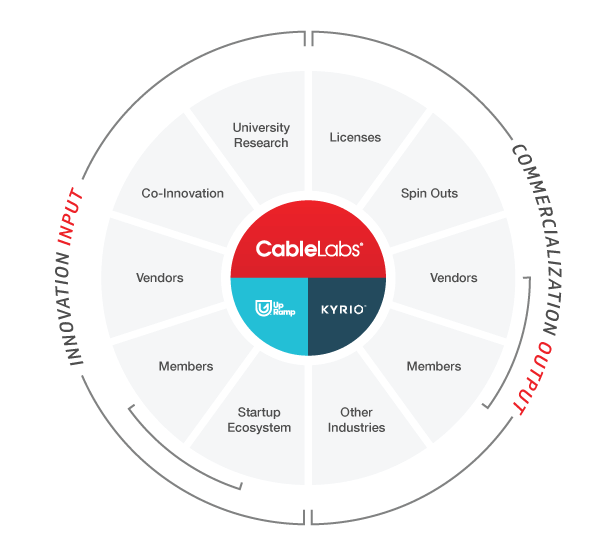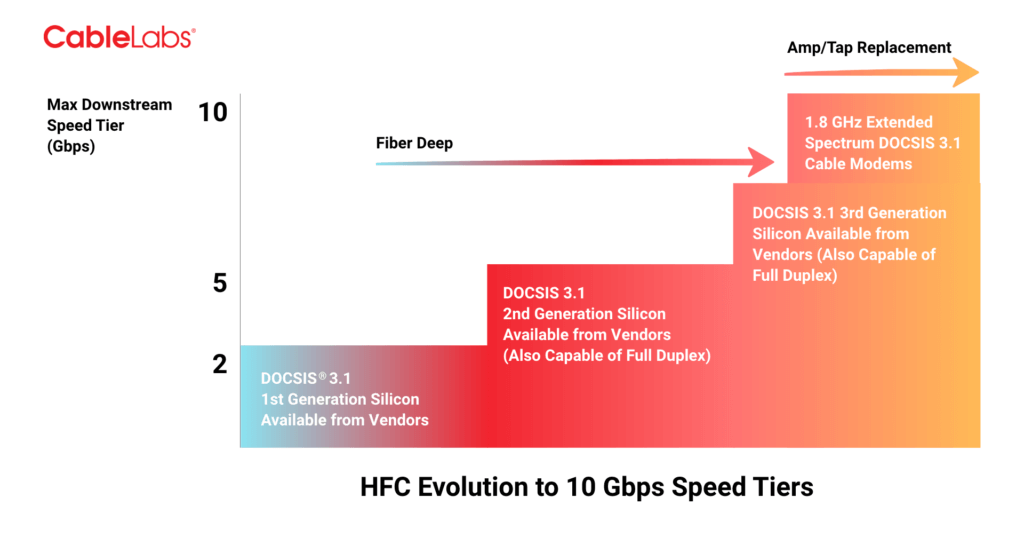Innovation
CableLabs Innovation Series: Transforming Ideas into Solutions

Innovation is both an art and a science. It is equal parts inspiration and hard work. It requires creativity and systems, passion and persistence. And most of all, innovation requires people — teams of people that work together to create what none of them could do on their own.
CableLabs is arguably one of the most impactful industry innovation labs in the world, generating immense value for the dollars invested by our members. A prime example:
Technology developed and specified at CableLabs is used by over half a billion people in the world every day, and the number is growing rapidly.
What is the secret to that success?
- Do we have better researchers?
- Do we have better leadership?
- Do we have better facilities?
While we do have great people, we have fewer than 200 of them, so surely other research groups vastly outnumber us. We do have good leaders, and excellent facilities, though we don’t believe we have a monopoly on these. So, none of these things by themselves explain the success we’ve had.
From the founding of CableLabs until today, we have recognized that our success derives from two things:
- Our position in an ecosystem, and our practical focus on building innovations that will really be adopted. The ecosystem is made up of companies, yes, but within these companies are individuals.
- And the real secret is that we multiply the impact of our almost 200 people by engaging with the ecosystem and bringing the power of thousands of additional people to bear on our industry’s needs.
Innovation
Ideas are where innovation starts, so CableLabs casts a wide net for ideas by working with our own teams, and also engaging the ecosystem around us. We create programs and often organize teams to gather participants from our members, from vendors, from academic researchers, co-innovation partners, and startups, as shown on the Innovation Input section of the diagram below. A few examples:
- Full Duplex DOCSIS: A technology that allows radio frequency spectrum to be simultaneously used for upstream and downstream communications on the cable plant, was inspired by an idea that we found through academic research work with Stanford a number of years ago.
- Low Latency DOCSIS Mobile Backhaul: Our work came out of a collaboration with Cisco, a major vendor to the cable industry.
- Proactive Network Maintenance: A CableLabs project that enables operators to find plant maintenance needs before they become customer impacting, resulted from a close collaboration with Comcast, one of our members.
- UpRamp: Our team engages deeply with the startup community, evaluating over 1,000 new startups every year to find the handful that will be selected for our Fiterator program.
- We also source ideas internally, collecting over 200 potentially impactful ideas every year from our teams at CableLabs, Kyrio, and UpRamp.
We take this big pile of ideas and systematically sort them, filtering out the ideas that won’t create enough impact, or the ideas that are best pursued by other parts of the ecosystem. Once we have an idea that we think has promise, the ecosystem engagement continues. We often work on the idea together with vendors, startups, and members to build and validate the idea, asking and answering questions like:
- Does the technology really work?
- Does it really save as much money as we thought?
- Does the customer really want it?
The ideas that make it through testing and still look good are ready to go to the next step.
Commercialization
Once we know that an idea has been validated and can have a major impact for our members, we turn our attention to commercialization. The end objective here is to really finish the race, which means that our work is not complete until members have deployed the technology and are generating revenue, cost savings, or improved user experiences with the idea. We get tired of hearing it, but our CEO Phil McKinney is right when he says that:
“Ideas without adoption are a hobby, and we aren’t in the hobby business.”
Here, we have a lot of tools in the toolkit, because it is important to use the right tool for the job with each individual idea. Broadly, as shown on the Commercialization Output section of the diagram above, our commercialization paths include:
- Specifying technology for production by the vendor ecosystem
- Licensing intellectual property, including contributions to open source communities
- Direct adoption by members or by other companies outside of the cable industry
- Commercializing services and digital products for member or non-member companies through our subsidiary, Kyrio
- Through our UpRamp subsidiary, helping startups adapt their products to the industry’s needs and having the startup make direct sales to cable operators
Here are a few examples of how we use these different commercialization paths:
- We created intellectual property when we developed our Proactive Network Maintenance (PNM) technologies, and now we license this intellectual property to the vendor ecosystem for use in products that serve our industry. It is free for use on member networks. For non-member networks, the vendors pay a fee.
- We developed systems and technology to support the use of digital security certificates in cable modems, and we leverage that work through Kyrio, which sells digital security certificates to many industries, including the energy, medical, and communications equipment industries.
- We work closely with vendors and members to help write the specifications for every DOCSIS release, and we test vendor DOCSIS gear against those specifications with Kyrio.
- We developed open source software for our SDN NFV Application Platform and Stack (SNAPS), and for our Low-Power Wide Area Networking LoRa Server, and license that software through the open source community.
It Takes an Ecosystem
Any world-class innovation effort needs to leverage ideas and resources throughout the ecosystem of suppliers, researchers, startups, and adopting companies or customers in order to find the best ideas and get them commercialized. At CableLabs, Kyrio, and UpRamp, we are continuing to develop the relationships with key ecosystem partners, because we know that we can’t achieve our mission to deliver impactful innovation without the whole ecosystem working together. It is only through collaboration that we can continue as one of the world’s most impactful industry innovation labs.
This is an introduction to how CableLabs' ideas become solutions. Subscribe to our blog to automatically receive the next installment of our CableLabs innovation story.

DOCSIS
The Golden Gigabit Internet Age

Over the past year, a quiet revolution in broadband services has been happening, thanks to investments cable operators are making around the globe: gigabit services are available to tens of millions households for the first time ever. Already, over half of households in North America can buy a 1 Gbps service from their cable operator, and the percentage is growing rapidly. This shift is driven by a new technology making it economically feasible for operators to provide gigabit services in most areas. And the technology is not limited to a single gigabit – it is capable of much higher speeds over time.
The technology? DOCSIS® 3.1. This innovation is now being quickly deployed by operators.
While the broad availability of gigabit services may have escaped notice, there is even less awareness of the potential for DOCSIS technology to provide higher speeds. With existing DOCSIS specifications and comforming vendor gear, operators could use DOCSIS to:
- Provide shared, downstream capacity of over 15 Gbps
- True downstream speed tiers of 10 Gbps or more for individual households
How can DOCSIS provide that much speed?
The technology is actually already in the DOCSIS 3.1 specifications. However, getting to these speeds will require an evolution of DOCSIS silicon, along with some outside plant improvements. Here is the roadmap:
As you can see, the first generation of DOCSIS 3.1 silicon has been available for deployment for over a year, and it enables downstream speed tiers of roughly 1-2 Gbps. As demand materializes for higher speed tiers, operators may ask silicon providers for a second and third generation of DOCSIS 3.1 silicon. Each new silicon generation supports broader frequency ranges for DOCSIS, possibly up to the full DOCSIS 3.1 limit of about 1.8 GHz. At the 1.8 GHz range limit, over 1.5 GHz of spectrum can be used for downstream DOCSIS 3.1 channels. At 10 bits per Hertz that is more than 15 Gbps of total capacity.
Expanding Spectrum
Most operators are using 1 GHz of spectrum (or less) in their networks today. If an operator wanted to use spectrum as high as 1.8 GHz in a high-demand neighborhood it can push fiber to within 800 feet of many homes, and install taps that can pass the full 1.8 GHz of spectrum.
Thanks to the work of our CableLabs members, homes in the tens of millions are gaining access to 1 gigabit services for the first time ever. With more homes enjoying gigabit and even higher speeds, there will be a growing market for application developers and artists to develop immersive entertainment and interactive network services such as those in our Near Future video series. Radiologists working from home will be able to move massive files back and forth from medical centers. Grandparents will join their grandchildren in virtual family rooms for a game of virtual Uno. Immersive holographic movies will stream to a new generation of entertainment devices. And this is only the beginning.
If you have been yearning for a gigabit service at your home, check with your local cable operator – gigabit services may already be available to you. And, if you want to learn more about the DOCSIS roadmap to 10 Gigabit services, please subscribe to our blog.

Culture
Dr. Bernardo Huberman Joins the CableLabs Team

Today, technology pioneer and futurist, Dr. Bernardo Huberman joins CableLabs as a Fellow and vice president of the Core Innovation Team. Based in our Silicon Valley office, Bernardo will lead our innovation efforts in the areas of artificial intelligence, PHY and MAC layer communications network technologies, and Software Defined Networking and Network Function Virtualization.
A former senior vice president at Hewlett Packard Enterprise Company and director of the Mechanisms and Design Lab at HP Labs, Dr. Huberman has over 30 years' experience in innovation. Originally from Argentina, he received his Ph.D. in physics from the University of Pennsylvania and is currently a consulting professor in the Department of Applied Physics at Stanford University.

Dr. Huberman has played a key role as a thought leader in numerous highly innovative solutions in technology. He began his career working in condensed matter physics and was one of the discoverers of chaos in numerous physical systems. He uncovered the nature of electronic markets, designed novel mechanisms for enhancing privacy and trust in e-commerce negotiations, and invented ePrint - the first system to allow remote printing from a mobile device anywhere in the world.
Recently, at HP, he discovered that unstructured information contained within the web could be harvested in the service of innovative new tools. An example of this is the development of technology-based machine learning that uses Twitter postings about movies and products to predict the precise amount of money and demand they would generate.
Bernardo has been an active participant and advisor in a number of important global technology and policy forums. He has participated in TEDx and has been a member of the Council of Nordic Ministers and the European Commission. He is a former Fellow at many influential technological societies and was co-winner of the IBM Prize of the Society for Computational Economics. He has held visiting professorships at the University of Paris, the University of Copenhagen, and the European School of Business. He holds 46 patents (with several pending) and has published hundreds of reports and several books.
As an accomplished leader and disruptor, CableLabs is delighted that Dr. Huberman is joining the team to continue our efforts in innovation.
Bernardo is taking the helm as VP of Core Innovation from Peter Smyth, who is retiring from CableLabs this week. Pete pioneered many initiatives in wireless technologies and has been instrumental in propelling our innovation efforts over the years. We would like to thank him for his contributions and wish him the very best in his retirement in the U.K.


